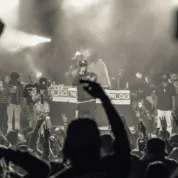
The 90s was a decade that shaped the genre of hip-hop like no other. From the message-centric lyrics of East Coast artists like KRS-One and Nas to West Coast songs that brought awareness to issues plaguing LA neighborhoods, the era was transformative. The Native Tongues introduced intellectualism and Afrocentric themes, while the 'Dirty South' challenged the East and West for hip-hop dominance.
If hip-hop was born in the 70s and 80s, then the 90s were its teenage years. Coined the "golden age of hip hop," this decade transformed this exciting new NY street sound from adolescence into the mature genre that now impacts music worldwide.
50 Best Hip-Hop Artists of the 90s

In Part 1 of this 2-Part series we looked at 50 groundbreaking artists that shaped the quintessential sound of 90s hip-hop. From pioneers like Run-DMC, Public Enemy and the Beastie Boys that brought it mainstream, to the huge names that made it legendary, such as Nas, A Tribe Called Quest, Tupac Shakur, Notorius B.I.G., many of which are showcased on our ranking of the Top 20 Greatest Rappers or All Time.
But the artists are only 1 side of the story. It was the songs that grabbed our attention, and had us head nodding, popping, and breaking in our Jyncos and Air Jordan 6s. The 100 best hip-hop songs of the 90s are the breakbeats, samples and rhymes, that captivated a generation, and shaped the sound we now know as the "Golden Age of Hip-Hop".
100 Best Hip-Hop Songs of the 90s
Three regions were responsible for producing the best hip-hop songs of the 90s, chronologically in this order:
- The East Coast continued to nurture this new sound, created on the streets of NY, with breakbeats, jazz samples and urban-focused lyricism.
- The West Coast got involved, with funk inspired beats, and narratives about local issues, gang life, and Latino culture.
- The Dirty South starting in Atlanta, brought a gospel-tinged, soul sound into the mix, with lyrics littered with an irresistible Southern-drawl.
Over the span of a decade, the best hip-hop songs of the 90s largely came from the diverse perspectives and sounds of these three locations.
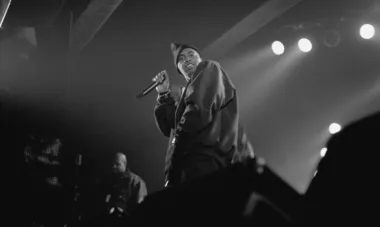
The songs in this article are NOT ranked best to worst. Instead, it aims to tell the story of 90s hip-hop, by walking through the history of each subgenre as they emerged, and listing the key songs that helped define those subgenres. The final result is not a popularity ranking, it's a list of 100 songs that truly helped shape the sound most often associated with 90s hip-hop.
Old School Hip Hop
The South Bronx in the late 1970s was simmering with untapped creativity. DJ Kool Herc was reinventing DJing by looping breakbeats, while Grandmaster Flash and the Furious Five added lyrical storytelling through rhymes.
A new art form was sprouting up from the underground clubs and block parties in NYC. Eventually, new artists took the sound and recorded tracks like Run-DMC's "It's Like That/Sucker MCs", and the Beastie Boy's "Rock Hard", introducing the new sound to mainstream audiences.
Many of these artists continued into the 90s, with tracks like LL Cool J's "Mama Said Knock You Out" and Eric B. & Rakim's "Don't Sweat the Technique", laying the groundwork for what many consider the best decade of hip-hop... the 90s.
- "It Takes Two" by Rob Base & DJ E-Z Rock (1988)
Utilizing an unforgettable sample of Lyn Collins's "Think (About It)," this song became a staple in hip-hop, with memorable lyrics fans still belt out to this day. - "Express Yourself" by N.W.A. (1988)
Despite N.W.A.'s reputation for gang violence, this track surprisingly critics, promoting self-expression and individuality. - "Bust a Move" by Young MC (1989)
A dance-floor staple, with comedic lyrics and one of the hottest bass-lines in hip-hop by Flea of the Red Hot Chili Peppers. - "Fight the Power" by Public Enemy (1989)
This anthem tackled social and political issues, becoming a voice for resistance against racial inequality. - "Shake Your Rump" by Beastie Boys (1989)
The first Hip-hop songs were comprised of one sample repeated or scratched over a breakbeat, as that's all the 2-turntable DJ setup allowed for. The Beastie Boys’ album "Paul's Boutique" changed all that, using creative recording techniques to string multiple samples together, and changing the sound of hip-hop forever. - "The Humpty Dance" by Digital Underground (1990)
Rapper Shock-G introduced his comedic alter-ego "Humpty Hump" to the world with this song, known for its wild bass-line, and catchy sing-a-long lyrics. - "Can I Kick It?" by A Tribe Called Quest (1990)
A popular sample from Lou Reed's "Walk on the Wild Side" created one hip-hop's first laid-back, jazzy vibes. - "Mama Said Knock You Out" by LL Cool J (1990)
Showcased LL Cool J's lyrical prowess and served as his comeback statement in the rap game. - "Don't Sweat the Technique" by Eric B. & Rakim (1992)
Highlighted Rakim's complex lyricism and Eric B.'s innovative sampling, influencing future East Coast rap. - "Down with the King" by Run-D.M.C. (1993)
The track revitalized Run-D.M.C.'s career while paying homage to their own influence on the hip-hop genre.
East Coast Hip-Hop
The gritty streets of New York served as the backdrop for early 90s hip-hop. 80s pioneers like Public Enemy were still at it, protested social issues in songs like "911 is a Joke". Soon after songs like "Juicy" by Notorious B.I.G and Nas's "N.Y. State of Mind" would capture the East Coast's complex sampling and storytelling.
The best hip-hop songs of the 90s from the East coast were anthems for New York city life, blending old-school influences with modern complexities. They not only defined a generation but also set a benchmark for lyricism in hip-hop music.
- "911 Is a Joke" by Public Enemy (1990)
A controversial track that directly called out policing inadequacies and racial biases in Black neighborhoods, forcing a political conversation via the airwaves in true Public Enemy fashion. - "Tonight's da Night" by Redman (1992)
With gritty lyrics and a moody, lo-fi beat, Redman set the stage for the raw hip-hop that would define much of the 90s. - "Method Man" by Method Man (1993)
This was the intro for Method Man, one of Wu-Tang Clan's most unique voices, known for his raspy flow and twisted humor. - "C.R.E.A.M." by Wu-Tang Clan (1993)
With the iconic line "Cash Rules Everything Around Me," this track shaped the dialogue about wealth and hustle in the hip-hop community. - "Code of the Streets" by Gang Starr (1994)
This song used jazzy samples masterfully, a technique DJ Premier continued to perfect over the years. - "Big Poppa" by Notorious B.I.G. (1994)
With its silky Isley Brothers sample and smooth flow, Biggie showed the world how hip-hop could be as suave as it was street. - "It Ain't Hard to Tell" by Nas (1994)
Nas sampled Michael Jackson's "Human Nature," and gave us intricate lyricism that seemed wise beyond his years. - "Shimmy Shimmy Ya" by Ol' Dirty Bastard (1995)
The track is pure ODB, unpredictable and rough around the edges, but irresistibly catchy. - "Dead Presidents II" by Jay-Z (1996)
The piano loop here became one of the most iconic beats in hip-hop, cementing Jay-Z's reputation as a hitmaker. - "It's Been A Long Time" by Rakim (1997)
Produced by DJ Premier, this song was a lyrical showcase for Rakim, who many consider the greatest MC of all time.
Boom Bap
"Mass Appeal" by Gang Starr and "N.Y. State of Mind" by Nas are popular 90s boom bap tracks. These songs embodied the essence of East Coast hip-hop, focusing on tight drum-kick and snare patterns. Their gritty, no-nonsense approach provided the soundtrack for urban narratives, displaying unmatched lyrical dexterity.
- "Scenario" by A Tribe Called Quest (1991)
The track featured a star-making verse from a young Busta Rhymes, propelling him into the hip-hop limelight. - "They Want EFX" by Das EFX (1992)
Known for its unique "iggity" style of rap, the song introduced a playful, tongue-twisting flow to hip-hop. - "Sound of da Police" by KRS-One (1993)
KRS-One took aim at systemic police brutality, making the track an anthem for social justice movements. - "N.Y. State of Mind" by Nas (1994)
Painting a vivid picture of life in the inner city, this track is a cornerstone of Nas's influential album, "Illmatic." - "Mass Appeal" by Gang Starr (1994)
Calling out the commercialization of hip-hop, Gang Starr blended a catchy melody with sharp social commentary. - "Flava in Ya Ear" by Craig Mack featuring Notorius BIG (1994)
With its minimalist beat and catchy hook, the track became an instant classic, driving the success of Bad Boy Records. - "Juicy" by Notorious B.I.G. (1994)
Biggie's rags-to-riches story over a sampled Mtume beat made this an instant hip-hop classic. - "Put It On" by Big L (1995)
Big L's intricate wordplay and Kid Capri's production made this track a staple in East Coast hip-hop. - "Woo Hah!! Got You All in Check" by Busta Rhymes (1996)
The track's wild energy and memorable chorus launched Busta Rhymes' solo career with a bang. - "Guess Who's Back" by Rakim (1997)
Coming off a hiatus, Rakim proved his lyrical prowess was intact, setting the tone for late-90s rap. - "Street Talkin'" by Slick Rick feat. OutKast (1999)
A late-'90s collaboration between hip-hop's earliest storytelling master Slick Rick, and the emerging newcomer OutKast, showcased a blend of old-school narrative technique and new-school flair.
West Coast Hip-Hop
As New York developed its complex lyrical styles, 3,000 miles away in California, artists like Dr. Dre were brewing up a different flavor with N.W.A. songs like "Panic Zone" and "Express Yourself". This West coast sound soon found itself in a cross-coastal rivalry, with diss tracks fueling sensational headlines.
Tracks like Tupac's "California Love" and Snoop Dogg's "Gin and Juice" often focused more on local issues and less on lyrical intricacy. The best hip-hop songs of the 90s from the West coast brought the sun-soaked and conflict-ridden stories of the West coast into the limelight, creating a polarizing East-West hip-hop landscape.
- "It's Funky Enough" by The D.O.C. (1989)
The D.O.C., a key contributor to N.W.A, showcased his rapid-fire flow over a funky beat, setting a new standard for West Coast rap. - "Same Song" by Digital Underground featuring Tupa Shakur (1991)
This track marked Tupac Shakur's recording debut, showcasing his versatile style alongside Digital Underground's playful vibe. Tupac would go on to become on of hip-hop's most legendary artists. - "Let Me Ride" by Dr. Dre (1992)
Off Dre's iconic "The Chronic" album, the song's laid-back G-funk sound helped define the West Coast rap scene. - "Jus Lyke Compton" by DJ Quik (1992)
DJ Quik addresses the spread of gangsta rap's influence, noting how cities outside of Compton began adopting the lifestyle. - "Insane in the Brain" by Cypress Hill (1993)
Known for its catchy, eccentric chorus, the track became a crossover hit and elevated Cypress Hill to stardom. - "Gin and Juice" by Snoop Dogg (1993)
Snoop Dogg's smooth flow over Dr. Dre's production made this an anthem for West Coast party culture. - "I Got 5 On It" by Luniz (1995)
A tribute to getting high on a budget, the track's eerie melody became instantly recognizable and is often sampled. - "Runnin" by Pharcyde (1995)
Produced by J Dilla, the song's introspective lyrics and jazzy beats made it a standout in Pharcyde's catalog. - "2 of Amerikaz Most Wanted" by Snoop Dogg & Tupac (1996)
This collaboration between two rap titans touched on their criminal charges and media scrutiny, becoming an anthem of defiance. - "Changes" by Tupac Shakur (1998)
Released posthumously, the track samples Bruce Hornsby and offers Tupac's poignant reflections on societal issues.
Gangsta Rap
Songs like "Straight Outta Compton" by N.W.A. and "Gangsta's Paradise" by Coolio gave voice to forgotten corners of America. These tracks, while controversial, were anthems of resistance and survival, presenting grim reports from America's underbelly in a way that couldn't be ignored.
Unfortunately the East-West coast rivalry would take a turn for the worse, with diss tracks like Tupac Shakur's "Hit 'Em Up" setting the stage for a tragedy that would claim the lives of not only Tupac himself, but Notorious B.I.G. as well, two of hip-hop's brightest stars.
- "Straight Outta Compton" by N.W.A. (1988)
This track kicked off gangsta rap, offering a raw portrayal of life in Compton and challenging mainstream narratives. - "Boyz-N-The-Hood" by Eazy-E (1988)
Eazy-E's debut solo track delves into the struggles of growing up in the hood, setting the tone for gangsta rap. - "How I Could Just Kill a Man" by Cypress Hill (1991)
This early Cypress Hill hit tackled issues like police violence and societal inequality over a sinister beat. - "Mind Playing Tricks on Me" by Geto Boys (1991)
The song explores the psychological toll of street life, making it an emotionally resonant gangsta rap anthem. - "It Was a Good Day" by Ice Cube (1992)
Ice Cube took a break from his usual hard-hitting themes to appreciate a simple, good day in this hit. - "Fantastic Voyage" by Coolio (1993)
Coolio's reimagining of Lakeside's hit became an early 90s staple, mixing funk and rap in an invitation to escape life's pressures. - "Check Yo Self" by Ice Cube (1993)
Sampling Grandmaster Flash's "The Message," Ice Cube warns about the consequences of reckless behavior. - "Murder Was the Case" by Snoop Dogg (1994)
This track explores the hypothetical scenario of Snoop's death and resurrection, surrounded by controversy due to his real-life murder trial. - "I Seen a Man Die" by Scarface (1994)
Scarface provides a haunting narrative about death and existential dread, showcasing his storytelling skills. - "Shook Ones Pt. II" by Mobb Deep (1995)
One of hip-hop's most iconic beats underlines Mobb Deep's tales of inner-city paranoia and danger.
Native Tongues
After the East vs. West clash, the Jungle Brothers' Native Tongues came like a breath of fresh air. Its members were contemporaries of both the Boom Bap and Gangsta Rap, but chose a different path. Hits like "Can I Kick It?" by A Tribe Called Quest and "Me Myself and I" by De La Soul, centered on Afrocentricity, intellectualism, and social issues without the aggressive edge, bringing a laid-back, intellectual vibe to the 90s hip-hop scene. The Native Tongues play a key role in the best hip-hop songs of the 90s, as the innovative work they did set the stage for multiple hip-hop subgenres to come.
- "Me Myself and I" by De La Soul (1989)
This track rebelled against the gangsta rap image, showcasing De La Soul's playful and introspective style. - "Because I Got it Like That" by Jungle Brothers (1989)
The song blended rap with house music elements, making it a pioneering effort in the fusion of the two genres. - "Monie in the Middle" by Monie Love (1990)
A track by British rapper and radio host, exploring a woman's perspective on relationships and autonomy. - "The Choice Is Yours" by Black Sheep (1991)
Known for its memorable chorus, "You can get with this, or you can get with that," this track remains an anthemic choice. - "Passin' Me By" by The Pharcyde (1992)
The song is a poignant take on unrequited love, set to a melancholic beat. - "Electric Relaxation" by A Tribe Called Quest (1993)
This smooth, jazzy tune has been widely sampled and stands as one of Tribe's most beloved tracks. - "No Equal" by The Beatnuts (1993)
One of Native Tongues' later members, this hip-hop duo from NY was one of hip-hop's first to fuse together an eclectic range of styles, including Latin, jazz, and soul elements. - "U.N.I.T.Y." by Queen Latifah (1993)
Queen Latifah tackles issues like street harassment and domestic violence in this empowering anthem. - "The Pressure" by A Tribe Called Quest (1996)
The track reflects on the stresses and struggles of life, underpinned by a jazzy, laid-back beat. - "Definition" by Most Def & Talib Kweli (1996)
Latecomers to the Native Tongue Family, Mos Def and Talib Kweli (aka Black Star) were known for their socially conscious lyrics and strong emphasis on storytelling.
Jazz Rap
Experimentation with jazz samples by early 90s artists like Q-Tip in songs like "Check the Rhyme" by A Tribe Called Quest, was adopted by others, eventually resulting in an entirely new jazz-influenced subgenre. Songs like "Rebirth of Slick" by Digable Planets borrowed heavily from classic jazz samples, delivering laid-back yet intricate compositions that showcased hip-hop’s versatility.
- "Doin' Our Own Dang" by Jungle Brothers (1989)
This collaboration-packed track features De La Soul and A Tribe Called Quest, embodying the Native Tongues collective's Afrocentric philosophy and focus on conscious rap. - "Check the Rhyme" by A Tribe Called Quest (1991)
In Tribe's early days, Q-Tip was said to spend hours at a time searching through old jazz albums to find samples for new tracks, such as this one which cleverly samples Minnie Riperton. His early work set the stage for the future of jazz rap. - "Inner City Boundaries" by Freestyle Fellowship (1991)
Highlighting the group's incredible vocal flexibility, the song was an early example of jazz-rap and showcased their skill at breakneck-speed lyricism. - "Otha Fish" by The Pharcyde (1992)
This track flipped the script on traditional love songs, offering a humorous, alternative perspective on romantic relationships. - "Stunts, Blunts & Hip Hop" by Diamond D (1992)
The song is off Diamond D's debut album, a landmark in the fusion of jazz samples with rugged rap, proving Diamond D's dual talents as an MC and producer. - "Soul Flower" by The Brand New Heavies (1992)
Part of the Acid Jazz movement, this track mixed live instrumentation with rap, featuring Pharcyde and challenging the drum machine-driven sound of the era. - "Rebirth of Slick (Cool Like Dat)" by Digable Planets (1993)
This Grammy-winning single sampled Art Blakey and introduced listeners to a jazzy, laid-back style of hip-hop, earning the group a "Best New Artist" nomination. - "The World Is Yours" by Nas (1994)
Produced by Pete Rock, the track's iconic piano loop and Nas's reflective lyricism make it a defining moment in his debut album "Illmatic," often cited as one of the greatest rap albums ever. - "Jettin'" by Digable Planets (1994)
The track is from their second album, "Blowout Comb," and tackles social issues with poetic finesse, underlining the group's commitment to conscious rap. - "Things Fall Apart" by The Roots (1999)
The title track from an album that won the Grammy for Best Rap Album, it’s an examination of the group’s social and political awareness, backed by live instrumentation that sets them apart.
G-Funk
Dr. Dre's "Nuthin' but a 'G' Thang" encapsulated G-Funk's blend of funk influences and gangsta rap themes. Tracks like this served as a softer rebuttal to the hardcore rap coming from the West coast, creating a new West Coast narrative influenced by the synthesizer-heavy funk sound of 70's bands like Parliament-Funkadelic.
- "Nuthin' but a 'G' Thang" by Dr. Dre (1992)
Released on Dre's seminal album "The Chronic," this track introduced Snoop Doggy Dogg and G-funk to the mainstream, fundamentally changing the rap landscape with its Parliament-Funkadelic samples. - "Who Am I? (What's My Name?)" by Snoop Dogg (1993)
Snoop's first solo single post-Dr. Dre collaboration helped solidify the distinct West Coast G-funk sound and played a pivotal role in making his debut album, "Doggystyle," a commercial success. - "Regulate" by Warren G & Nate Dogg (1994)
This storytelling duet sampled Michael McDonald's "I Keep Forgettin'" and became an anthem for the G-funk era, showcasing Warren G's production skills and Nate Dogg's unique vocal style. - "Let's Play House" by Tha Dogg Pound (1995)
Featuring George Clinton and Michel'le, the track continued the G-funk theme while offering a smoother, R&B-inflected take, reflecting Tha Dogg Pound's versatility. - "California Love" by Tupac Shakur (1995)
Featuring Dr. Dre and Roger Troutman, this anthem put Tupac's charisma front and center. Released shortly after his prison stint, it became a West Coast anthem and is one of the best-selling singles of all time.
Dungeon Family
While the East and West fought for hip-hop dominance over the best hip-hop songs of the 90s, kids in Atlanta, Georgia with names like Big Boi, CeeLo Breen, Lisa "Left Eye" Lopes, and Andre 3000, among others, were in Rico Wade's mother's basement, experimenting with a new sound that would take everyone by surprise. The result was songs like OutKast's "Elevators" and Goodie Mob's "Cell Therapy". These tracks took 90s hip-hop to a another level, by blending complex rhyming patterns with a Southern drawl, over the soulful and gospel sounds of the "Dirty South".
- "Player's Ball" by OutKast (1993)
OutKast's debut single emerged from The Dungeon, a clay-walled basement in Atlanta where the duo along with producers Organized Noize laid the groundwork for a unique blend of Southern hip-hop. - "Cell Therapy" by Goodie Mob (1995)
The debut single from Goodie Mob's debut album, and another Dungeon Family trademark song. The Dungeon served as a haven for members like CeeLo Green to explore more conscious, soul-inflected rap. - "Dirty South" by Goodie Mob (1995)
A seminal track from the Dungeon Family collective, "Dirty South" coined the term for a subgenre and regional identity, shaping the future of Southern hip-hop. - "ATLiens" by OutKast (1996)
Fueled by the Dungeon Family’s creative spirit, this title track from OutKast's second album leaned into a more introspective, extraterrestrial aesthetic that contrasted sharply with prevailing gangsta rap. - "Set It Off" by Organized Noize (1996)
Organized Noize, the key Dungeon Family production trio, showcased their sonic diversity with this track, further establishing Dungeon Family's unique blend of funk, soul, and Southern rap. - "Rosa Parks" by OutKast (1998)
By this point, Dungeon Family's influence had begun to resonate nationally. This Grammy-nominated hit featured harmonica solos and acoustic guitars, elements seldom found in hip-hop but integral to the Dungeon Family's eclectic sound.
Alternative Hip-Hop
Alternative chart-topping hits like "Jump Around" by House of Pain showcased hip-hop's experimental edge. Ethnic and cultural diversity among new artists produced songs with a plethora of new sounds and techniques, stretching the boundaries of the best hip-hop songs of the 90s.
- "Strobelite Honey" by Black Sheep (1991)
This song humorously dissects a night out, combining catchy hooks with social observation - "Mistadobalina" by Del Tha Funkee Homosapien (1991)
A cousin of Ice Cube, Del used this track to distance himself from West Coast gangsta rap, diving into complex wordplay and a catchy, Parliament-Funkadelic sample. - "Case of the PTA" by Leaders of the New School (1991)
This group, including a young Busta Rhymes, made waves with this energetic song about school troubles, using humor and animated delivery to stand apart. - "Jump Around" by House of Pain (1992)
This Irish-American group captured attention with a high-energy track that has since become synonymous with sports events and parties, marking a unique moment in hip-hop. - "360° (What Goes Around)" by Grand Puba (1992)
Grand Puba's lyrical focus on social issues and self-empowerment set the stage for future rappers to move away from solely braggadocious content. - "So What'cha Want" by Beastie Boys (1992)
As one of hip-hop's founders, for 30 years the Beastie Boy's were constantly searching for alternative ways to perform and record, such as this U.S. Billboard Hot 100 single which featured distorted vocals by running their mics through a guitar amplifier with high gain. - "93 'til Infinity" by Souls of Mischief (1993)
Part of the Hieroglyphics collective, this Oakland group used this classic to showcase lyrical complexity and a jazz-infused beat, heralding a new lane of intellectual rap. - "Wopbabalubop" by Funkdoobiest (1995)
Produced by DJ Muggs of Cypress Hill, the song's fusion of Latin rhythms and gritty rap marked it as an alternative hip-hop standout. - "Ready or Not" by The Fugees (1996)
Co-produced by Lauryn Hill, this track blended R&B and rap in a manner few had seen, shattering the limitations of hip-hop's mainstream sound. - "My Name Is" by Eminem (1999)
Using a sample from a 1975 Labi Siffre song, Eminem burst into the mainstream with this irreverent, self-deprecating track that set the tone for his future success.
Hardcore Rap
Echoing the seismic shifts and aggressive edge in rock music at the time, hardcore rap also came to prominence, with Songs like Wu-Tang Clan's "C.R.E.A.M." and Mobb Deep's "Shook Ones Pt. II". They amplified hip-hop's foundational elements with a heavy dose of aggression and raw intensity. The beats were harder, the lyrics grittier, and the overall sound was as unfiltered as it was uncompromising.
- "Slam" by Onyx (1993)
This track thrust Onyx into the mainstream, defined by its aggressive shouts and a mosh-pit-friendly beat, becoming a landmark in hardcore rap. - "Sound of da Police" by KRS-One (1993)
With its biting social critique, KRS-One challenged law enforcement's treatment of Black communities, making it an enduring anthem for justice movements. - "Wu-Tang Clan Ain't Nuthing ta F' Wit" by Wu-Tang Clan (1993)
This track showcased the Clan's unique blend of kung-fu references and gritty street tales, solidifying their place in hardcore hip-hop. - "Ruff Ryders' Anthem" by DMX (1998)
Produced by Swizz Beatz, DMX's raspy voice and the song's menacing beat became a calling card for the Ruff Ryders label and redefined East Coast hardcore rap. - "Twinz (Deep Cover '98)" by Big Pun and Fat Joe (1998)
Sampling Dr. Dre's "Deep Cover," the song featured rapid-fire lyricism from both rappers, marking it as a high point in late-90s hardcore rap and showcasing Latinx influence in the genre.
Rap Rock
The collaboration between Public Enemy and Anthrax on "Bring the Noise" in 1991, paved the way for more adventurous genre blending. Other collaborations like the Judgement Night soundtrack in 1993 followed. Meanwhile the Beastie Boy's versatility to incorporate live instrument samples in songs like "Pass the Mic", and to crossover into rock completely in other songs like "Sabotage", helped many unlikely rock fans crossover into hip-hop. These artists made a bold statement that rock and hip-hop not only could coexist but could create something extraordinary together.
- "Deeper Shade of Soul" by Urban Dance Squad (1990)
This lesser known Dutch band was ahead of their time, combining rock, funk, and hip-hop as early as 1989, making them earliest pioneers of the Rap Rock genre. - "Bring the Noise" by Public Enemy & Anthrax (1991)
A landmark collaboration, this track fused Anthrax's thrash metal with Public Enemy's political hip-hop, breaking down barriers between genres, and opening the doors of hip-hop to many rock fans. - "So What'cha Want" by Beastie Boys (1992)
With its distorted vocals and guitar riffs, for 30 years the Beastie Boys blurred the lines between hip-hop and rock, alternating between hip-hop and live instrument sets at shows, and finding inventive ways to combine samples and live instrument tracks in the studio. - "Homebrew" by 311 (1994)
311 was one of the earliest bands to fully adopt the rap rock genre, blending together rock, reggae, funk, and rap, and leading the 90s wave of rock bands that were heavily influenced by hip-hop rhythms and themes. - "N 2 Gether Now" by Limp Bizkit featuring Method Man (1999)
Known for blending nu-metal and hip-hop, Limp Bizkit gained mainstream success in the late 90s, becoming the rap rock band most closely tied to traditional hip-hop, bringing House of Pain's DJ Lethal into their line-up, and collaborating with rappers like Method Man of the Wu-Tang Clan.
The Golden Age of Hip-Hop
... wasn't just a decade of good music, it was a turning point in the evolution of hip-hop. It was a period where the elementary breakbeats and samples of the 80s, transcended its roots to become an expressive outlet for storytelling, political dissent, ethnic and cultural expression, and a global phenomenon. The nostalgic vibe of the best hip-hop songs of the 90s that we experience today while listening to Bonita Applebum for the 5,000th time, exists solely due to their groundbreaking and innovative contributions.
If you enjoyed this article on the 100 Best Hip-hop Songs of the 90s, make sure to also check out the 1st part of this 2-Part series, on the top 50 hip-hop artists of the 90s. And drop a comment below to let us know which 90s hip-hop songs are your favorite.

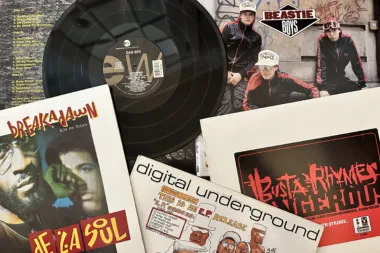
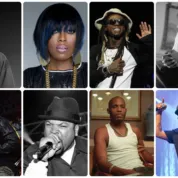
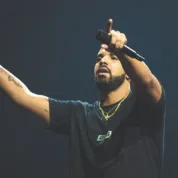

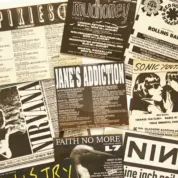

Leave a Reply!
I am a "reggae loving"Jamaican who is happy to see the music from my old country grow
Tribe called quest takes me back
A++ for the Beatnuts plug :D